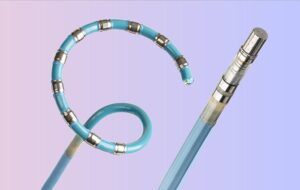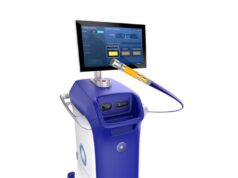This article was sponsored by Biosense Webster

According to data published by Patrick M McCarthy (Feinberg School of Medicine, Chicago, USA) and colleagues in the Journal of Clinical Medicine, AF affects 1%—roughly 33 million—of patients in the western population, a figure that is predicted to double by 2050.
Patients with AF are most commonly prescribed oral medications, however due to the increasing prevalence of the disease and its associated mortality/morbidity, interventional therapies are more frequently considered.
Radiofrequency (RF) catheter ablation was first to emerge—a treatment method which utilises thermal energy to disrupt abnormal electrical pathways in the heart that cause common arrhythmias. Reflecting on its efficacy to date, electrophysiologist Mattias Duytschaever (St Jan Hospital, Bruges, Belgium) tells Cardiac Rhythm News that RF ablation has been known to cause unintended thermal injury, such as oesophageal ulcers and atrioesophageal fistulas. Though, despite its challenges, he asserted RF has undoubtedly been the “cornerstone” technique for treating AF. Today, reaching its “ultimate optimisation” he opined, RF maintains high levels of efficacy and safety, yet the method still has equally high operator dependency due to the skill required avoid collateral thermal damage.
Representing a new, investigational approach to treating AF, PFA employs a controlled electric field to selectively ablate cardiac tissue via irreversible electroporation (IRE). Dating back to 1980, Vivek Reddy (Icahn School of Medicine, New York, United States) and colleagues reported the first-in-man results using PFA, initiating a departure from RF catheter ablation which was the existing method of treatment at the time. As a non-thermal option for AF, PFA has been viewed as an exciting potential alternative to RF, which may reduce the risk of damage to surrounding tissues including oesophageal, pulmonary vein, and phrenic nerve tissue.
The inspIRE study
With these advances in mind, electrophysiologists have looked to comparative data to assess the efficacy of both RF and PFA and the developing range of devices available to address the growing demands AF poses. Referring to the inspIRE study in which he was the first author, Duytschaever and his team evaluated the safety and effectiveness of the VARIPULSE catheter (Biosense Webster)—the first clinical study for the PFA system with full electroanatomical mapping integration. VARIPULSE is an investigational device, and is not currently approved for sale anywhere in the world.
Including 13 centres across Europe and Canada, Duytschaever et al enrolled 226 participants to receive PFA. Splitting patients into wave I (40) and wave II (186), wave I demonstrated no subsequent oesophageal thermal lesions or pulmonary vein (PV) stenosis. Of the wave II results, Duytschaever emphasised the outcomes within ablation research which showed no primary adverse events. Furthermore, primary efficacy was achieved in 70.9%, and 12-month freedom from symptomatic AF/atrial flutter/atrial tachycardia recurrence and repeat ablation was 78.9% and 92.3%, respectively.

Forerunners in the development of AF ablation catheters, Biosense Webster have been evolving their portfolio of devices, incorporating new technologies to address increasing procedural demands. Looking back over 20 years of innovation, Celine Martin, company group chairman of Johnson & Johnson’s Cardiovascular and Specialty Solutions (CSS) group, described the steps the company has taken to become a leader in the field of electrophysiology devices.
Martin recalled the earliest innovations, detailing the CARTO navigation-enabled ablation catheter which provides electromagnetic information to track the catheter tip. “From there the technology portfolio has evolved” Martin explained, highlighting their progression to RF catheters and to irrigated technologies, and the development of their CARTO system which supports thermal contact sensing. Continually seeking new ways to optimise energy delivery, Martin noted that Biosense Webster’s recent designs employ a “refined and sophisticated” tip to deliver high levels of RF energy to minimise risk of thermal injury.
The Biosense Webster RF catheter portfolio is comprehensive, Martin stated, and its innovations have worked to address safety concerns so that specialists can benefit from greater efficiency. But, “we realise the space is evolving” she asserted, “PFA is the next frontier”. Their development of the VARIPULSE PFA catheter aims to advance this evolution and “unleash” more physicians who can perform safe and efficient AF ablation procedures. “Having been in the field of AF ablation for 20 years, I have never seen as much excitement as now with PFA”, said Martin.

VARIPULSE uses multielectrode-based technology that combines Biosense Webster’s foundational navigation system with essential tools such as tissue proximity indication and catheter tracking.
True of any novel device however, Martin expresses that researchers are learning of potential complications that come with PFA, such as coronary spasm: “With new technologies there is always a trade-off. Today the safety profile related to complications appears to be better by virtue of the mechanism of action, but there are issues we need to address.”
A hybrid technique: RF and PFA
Tallying the pros and cons of RF and PFA side-by-side, Martin is uncertain that either RF or PFA will be preferred over the other. “Our projections suggest that by 2028 more than 50% of catheters used will be PFA-powered, but we believe that RF has a role to play as a proven and effective technology” she explained, noting that the company firmly believes “hybrid technologies” that combine RF and PFA will be the next fruition. This was echoed by Duytschaever, who affirmed that in combining what has been learned from RF with the “ease of PFA” as an energy source, electrophysiologists could have “the best of both worlds”.
In continued research efforts to explore a hybrid approach, Biosense Webster’s active SmartfIRE prospective, multicentre, single-arm study has enrolled 135 patients in Europe, to evaluate the safety and effectiveness of the dual PF/RF ablation system. The study will compare the system for the treatment of drug refractory symptomatic paroxysmal AF during standard electrophysiology mapping and ablation procedures.
Biosense Webster’s ongoing research efforts hope to bring “confidence” to both physician and patient, to develop hybrid, versatile, and patient-tailored treatments that account for unique anatomical characteristics. “From our standpoint, we believe PFA is a new chapter in the AF ablation book, but it is not a new book. It will be highly complementary to existing tools we have” Martin said. “We believe that our currently available catheters continue to be the most advanced technologies at this point in time, based on proven safety and effectiveness. Our portfolio will continue to evolve, and it is important to emphasise that it is not just one tool that performs the procedure, but an ecosystem of technologies which are needed to provide effective and efficient treatment.”









